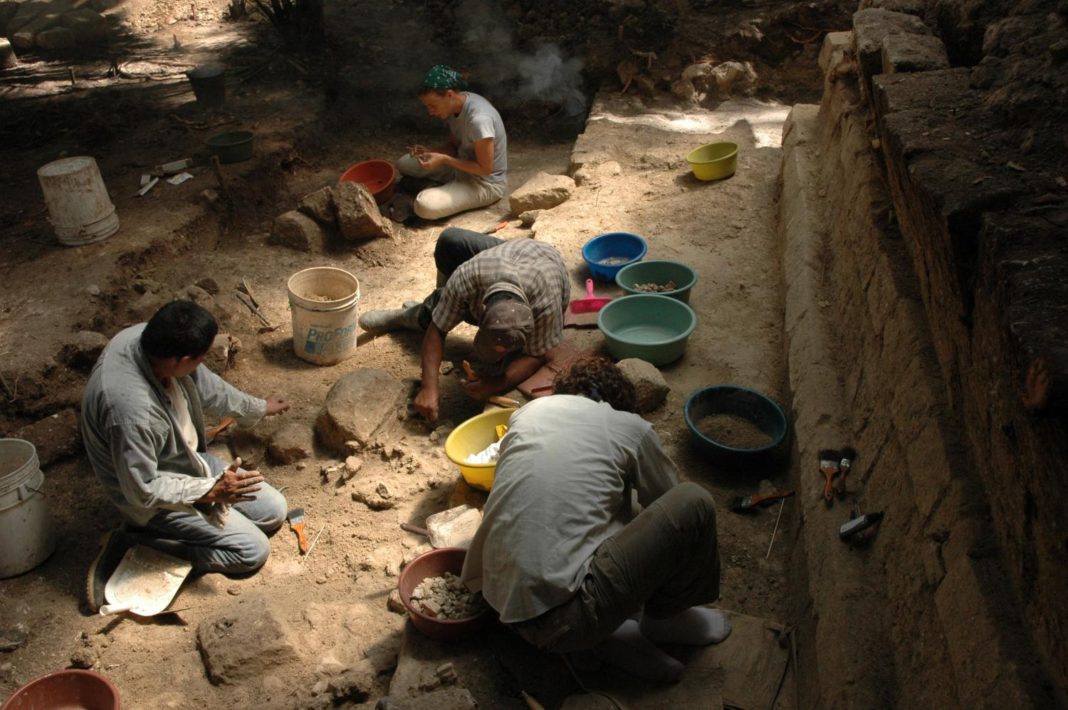Archaeologists excavate through the A-24 platform to reach the foundations, dated to about 1,000 B.C.
PHOTOGRAPH COURTESY TAKESHI INOMATA
Civilizations rise and fall, often in dramatic fashion. Their origins, though, are subtler and tend to be overlooked or poorly understood.
In the case of the Maya, a new paper in Science magazine sheds surprising light on that murky early period.
The classic period of the lowland Maya in Mesoamerica (A.D. 300 to 950) is a popular topic in archaeology, but little is known about the early preclassic era (before 1000 B.C.). Scientists are typically split between two theories on the subject: Either the Maya developed directly from an older“mother culture” known as the Olmec, or they sprang into existence independently.
Takeshi Inomata, professor of anthropology at the University of Arizona and a National Geographic research grantee, disagrees with both theories. In his work at the archaeological site of Ceibal in Guatemala, he has unearthed evidence for a more complex origin story.
Early Ritual Spaces
The Maya are usually associated with monumental architecture. Massive pyramids and immense plazas testify to a complex and fascinating culture.One can hardly hear the word “Maya” without imagining elaborately decorated kings and priests climbing the long, steep stairs of pyramids like those at Tikal.
But pyramids don’t just spring out of the jungle overnight, nor does a complex culture merely appear. Inomata and his team dug below the monumental architecture at Ceibal to see how such structures began.
Inomata assumed that the now iconic classic architecture probably stood on earlier sites used for similar purposes. His assumption turned out to be correct. He found smaller platforms built of earth beneath the pyramids of stone, signaling a formal ritual complex at Ceibal dating to around 1000 B.C.
The presence of ritual architecture early in the development of the Maya is an indication of a settled lifestyle with complex agriculture, religion, and a stratified society—all of which add up to a unified culture and the beginnings of a larger civilization.
Redefining the Olmec Connection
Experts have traditionally believed that when the Olmec were busy building their civilization at large sites such as La Venta, near the Gulf coast in modern Mexico, the people who would become the Maya were living in loosely associated nomadic groups in the jungles to the east and southeast. This theory holds that the Maya derived their entire society—including their architecture and social structure—directly from the Olmec.
But Inomata’s work has revealed that the Olmec is not an older civilization. In fact, Ceibal pre-dates La Venta by as long as two centuries. And although some Olmec cities are indeed older than both La Venta and Ceibal, they likely did not interact with the Maya.
“This does not mean that the Maya developed independently,” Inomata says. Instead, he believes, the influence flowed both ways. La Venta and Ceibal appear to have developed in tandem in a great cultural shift throughout the region. “It seems more likely that there was a broad history of interactions across these regions, and through these interactions, a new form of society developed.”
More Flexible Definitions
To further complicate matters, Inomata stresses that the evidence doesn’t show clear distinctions between the Olmec and Maya at the preclassic stage.
The two civilizations are easy to differentiate during the classic period, since the Maya had by then developed a distinct language and culture. But the period between 1000 and 700 B.C. is more transitional. With La Venta and Ceibal freely trading ideas, technologies, cultural elements, and perhaps even population, it’s difficult to call one Olmec and the other Maya.
“Determining labels for these early people is quite a tricky question—we’re not sure if residents of early Ceibal were wholly Mayan,” says Inomata. “We have decided to take a much more flexible approach, avoiding fixed labels in favor of looking at patterns of interaction and how more stable identities developed.”
An Agricultural Revolution
Inomata and his team will spend the next three years analyzing the findings from Ceibal. They will then begin to excavate outside the site’s center, hoping to gain an understanding of what day-to-day life was like in the preclassic period.
The peripheral areas, separated from the ritual plazas and temples, could hold more keys to the origins of the Maya. Inomata believes that the residential and agricultural areas are particularly important.
Around 1000 B.C. the previously nomadic groups that became the Maya began to build urban ritual areas. “Instead of starting with villages,” Inomata says, “they made a ceremonial center.” The idea for that may have come from the people who later created La Venta.
A radical shift in agriculture at that time may also have played an important role in the move to a more settled lifestyle. Corn, the principal crop of the Maya, “became much more productive,” says Inomata. “And then it made sense to cut down forests and increase agriculture.”
Inomata believes this agricultural revolution may have been rooted in genetic changes in the corn plant itself. But this, like so many other ideas about the rise and fall of the Maya civilization, still requires much more evidence to prove.












